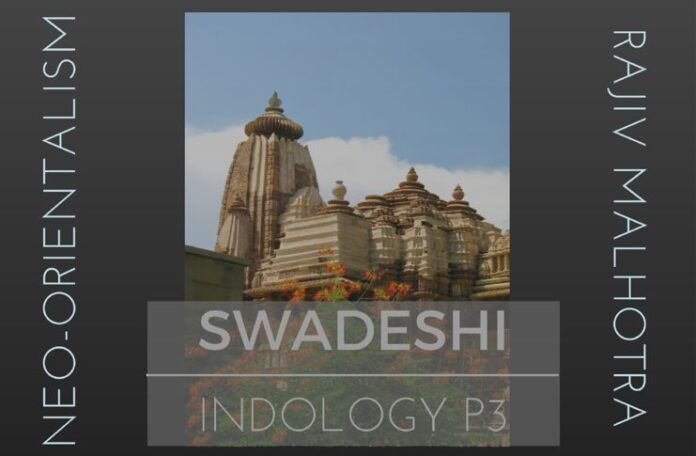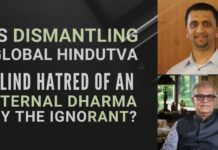
Part 1 of this series can be accessed here. Part 2 is available here.
[dropcap color=”#008040″ boxed=”yes” boxed_radius=”8px” class=”” id=””]T[/dropcap]he latest thing that they have developed is the Neo-orientalism of which Sheldon Pollock is the leader. And this is a very different kind of threat because they don’t hate Sanskrit, in fact they love Sanskrit. They love Sanskrit for the reason that understanding Sanskrit gives them an insight into the “oppressive minds” of the Vedic people. So they read Sanskrit with an agenda. They want to promote Sanskrit but with an agenda. They like the ‘Kavya’. They like the art, the aesthetics and these kinds of things but they interpret them from a certain point of view. So that’s the latest thing that was going on. So each of these schools of Indology, has started with the claim that it is going to decolonize. It started with that. It’s going to bring freedom to the Indian people, to the underclass, to the subaltern, to the minorities. It’s almost like freedom from India. Not freedom for India but freedom from India. That’s the sort of motto of this new trend – Indology.
Going out of their comfort zone, understanding the Kurukshetra first hand, and then developing a perspective and able to respond to it.
Now it is important to note that Indians are the scholars doing these works. They are compensated, paid, rewarded, evaluated by the western people in those Ivy Leagues and so on. But the brunt of the work is done by Indians and they are doing it very enthusiastically.
So the ‘Kurukshetra’ keeps changing. And so any Kshatriya has to understand the latest Kurukshetra, you can’t say long ago they had this weapon, we had that weapon, we are okay. That doesn’t work. You have to be in the Kurukshetra, you have to take the bullets, you have to fight, understand what’s going on, give back your answers, stand there responding to them, that is the ‘Tapasya’ you need to do. And we don’t have people doing that. We don’t have enough people actually going out and doing that. Going out of their comfort zone, understanding the Kurukshetra first hand, and then developing a perspective and able to respond to it. That is what we need.
[dropcap color=”#008040″ boxed=”yes” boxed_radius=”8px” class=”” id=””]T[/dropcap]he latest trend in this field is American think tanks in India. So we have Carnegie-India, Brooklyn-India, and Ford Foundation. Ford Foundation would setup NGO’s in the villages, this is for women, this is for different targets under the guise of helping poor people. They help poor people, there’s no doubt about that. But in the guise of helping poor people, they also infiltrated and got themselves to the system and then they could also manipulate them politically. So initially it started with foreign funded NGO’s. But now, there is a new target – it is the young westernized Indian elite who have come back from Ivy Leagues, who are children of top government officials, who are the future power brokers of India – These are being captured. And they are not going to be captured by some NGO, they are not working for NGOs, they are working for best private sector companies. So they are working for industry or government or whatever.
So they understand the American point of view, the American strategy, the American way of analyzing and thinking, and these persons bring that into India.
Therefore to influence the top level decision makers, the American think tank branches were started in India. The people who came from very sophisticated, very polished background, very well read, connected with this media elite, they are the prime people being brought into the American think tanks. So they understand the American point of view, the American strategy, the American way of analyzing and thinking, and these persons bring that into India.
So, initially, it will be all nice projects. How to solve India’s water problem, how to solve energy problem, public health, all that is very good. It is like the missionaries, when they go to a village, first it is Saam + Daan, then later comes Bhed + Dand. ‘Saam’ means we are all one, we care for each other, ‘Daan’ means helping and charity, we are here to save you. Then comes ‘Bhed’ – manipulating divisiveness, this guy is exploiting you, and ‘Dand’ is the clash. So the think tanks are very clever. They are not coming here with some open agenda. They are coming here to first appropriate the elite. So if you are a well-educated person, polished, good speaker, you got a job there. They will love to hire such people. In the Times Lit Fest, where I spoke, it is interesting that the in-charge of this lit-fest is Sagarika Ghose, and the other panelists are all Indians working in the American think tanks.
[dropcap color=”#008040″ boxed=”yes” boxed_radius=”8px” class=”” id=””]S[/dropcap]o the views being spun, are not really our Drishti. It is not truly our point of view. It is like, imagine a Cricket game where you appoint the players of other side. You appoint the referees, umpires and you appoint the players of the other side also because you control the Academy which produces these people and you supply them to your side also. See that’s how it is becoming. Or imagine, if Pakistan were to say, we have a very good military officer academy, we supply officers, you can send your officers, we will train them and we will give you good discount, we won’t charge any money. We will train your people. Or imagine if the Vatican were to say, we will start a Hindu seminary and we will train Pandits and they will be wearing proper ‘Dhoti’ and ‘Tilaks’ and very good ‘Shastra’ knowledge and they will be exactly as per your requirement. We will train them and we will give them good benefits. We will give them social security, we will give them pension, we will make a high-class outsourcing service for your temples. This is the kind of thing. When I say this to people, a lot of people say “what is wrong? I mean if they could do it properly, then why not?” A lot of people think like that. So these American think-tanks coming here are not a problem. They are not invaliding the law. They have every right to do that. From their point of view they should be doing that. There’s nothing wrong in letting them be here. Only problem I have is where are the Indian think-tanks. And it’s not a simple matter of saying “ki humne think-tank shuru kar diya hai”(We have already started the think-tanks). Yesterday we went to respected Swami ji, and he says “humne ek think-tank shuru kar diya hai”(We have started a think-tank) and he named some people who are in his think-tank. But they are just people who go to seminars, meet, gatherings and give talks. They are not deep researchers. They are not having a solid research. I know of several so-called think-tanks, our people have started. But it’s a ‘khaali’(empty) tank, there’s no thinking. It’s just empty tank. You go there and there’s no thinking, no output, you are just(empty) tank. So, there’s more to this and I want to discuss a little bit more.
The Indian diplomats tends to know their Nuclear policy, the Kashmir policy, but when it comes to civilization he knows Cricket and Bollywood and he can organize a ‘Bhangra’ in the embassy, that is civilization.
This was the history, now, I want to tell you what the state of affairs is today. The state of affairs is that this colonization has entered many organs of the body. If you think of disease, if you think of infection, this has spread to many organs of the body. Certainly, it’s in the academics, in the Social Science and Humanities. Certainly it’s in the NCERT books and education system in general, but it is also in government. I was called by the Foreign Service Institute, which is near JNU year or two ago, to give a talk. They train IFS officers, the batch had 30 people that year. The Director called me, so I went there to give a talk to these 30 Foreign Service people. My talk was on “How to represent the Indian Grand Narrative as a Diplomat” because when you go overseas, the Chinese diplomat knows his narrative, very positive, proud. Japanese knows. French knows. All these different countries, their diplomats know all that. The Indian diplomats tends to know their Nuclear policy, the Kashmir policy, but when it comes to civilization he knows Cricket and Bollywood and he can organize a ‘Bhangra’ in the embassy, that is civilization. So we can’t even be ourselves. Even our own embassies. So I gave a talk to these Foreign Service Institute people, this is after Modi’s election about a year or so ago. And the room was divided in to kinds of young people.
Half of them were very proud, they said this is so good. Some speaker has come to tell us this, we wish we had more. They wanted my card, they wanted to learn more, they wanted to know what to read because a sense of pride was in them and they felt it was very important as diplomats to know these things and we would like to learn. But the disappointment is the other half were vocally upset at the topic. One of them stood up and said, “I am from North-east, I don’t believe in this Indian Grand narrative. What is this Indian Grand Narrative?” Another one said, I am a Dalit and I think what you are describing as the Indian Grand Narrative are the people who oppressed my ancestors. So this business of fault lines, Dalit fault lines, Dravidian fault lines, minority fault lines that I’ve talked about in some of my books, this is also in the diplomatic service. It means this kind of person who is going to represent us. What kind of representation are we getting with these people? It’s like you have a Vice-President of sales, he doesn’t like your brand, he doesn’t like your product, he thinks there’s something wrong in your product. Why would you have such a person? So, to be a diplomat, there should be some kind of patriotism requirement.
To be Continued…
You can get connected with Rajiv in any one of the following ways:
Join Rajiv Malhotra for his FB LIVE Broadcasts. Follow Rajiv on facebook.com/RajivMalhotra.Official
Twitter: https://twitter.com/RajivMessage
You Tube Video of Rajiv Malhotra: https://www.youtube.com/user/BreakingIndia
Rajiv’s discussion egroup: http://groups.yahoo.com/group/RajivMalhotraDiscussion/
Email address : Infinity.Foundation.India@gmail.com
Note:
1. Text in Blue points to additional data on the topic.
2. The views expressed here are those of the author and do not necessarily represent or reflect the views of PGurus.
- Part 2: Discussion between Dr. Swamy and Rajiv Malhotra - September 10, 2017
- Dr Subramanian Swamy In Conversation with Rajiv Malhotra - July 24, 2017
- P2 – Discussing the Digestion of Yoga with a White Hindu - July 3, 2017











First change or rewrite history of CBSE in right way.
History should represent all bharat history not only congress and Muslims.
I am not against Muslims but Muslims should also know how much there ancestors damage this country .
These invaders only demolishes the temples,buildings,library or only change the name of Hindu buildings.they should be hatred for that but they feel proud because of this wrong history .
Peoples should also know the truth of British,american and Russia in history and political books not the Gujarat and babri